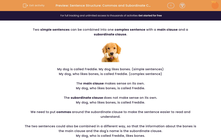Two simple sentences can be combined into one complex sentence with a main clause and a subordinate clause.
When the subordinate clause is placed in the middle of the main clause, it is known as an embedded clause and is separated from the main clause with commas.

My dog is called Freddie. My dog likes bones. (simple sentences)
My dog, who likes bones, is called Freddie. (complex sentence)
The main clause, highlighted below, makes sense on its own.
My dog, who likes bones, is called Freddie.
The subordinate clause does not make sense on its own.
My dog, who likes bones, is called Freddie.
The two sentences could also be combined in a different way, so that the information about the bones is the main clause and the dog's name is the subordinate clause.
My dog, who is called Freddie, likes bones.
In both examples, the subordinate clause is in the middle of the sentence and is separated from the main clause by commas. This type of subordinate clause is also known as a relative clause because it is linked to the noun in the main clause by the use of words such as who, which and that.
When we combine sentences in this way, we use the linking word who for people and pets and which for other animals and non-living things:
The tiger, which had finished its meal, was lying under the tree.

The car, which had cost a lot of money, was parked on the drive.

If you are ready, let's start the questions - you can always come back here if you need to check anything!








